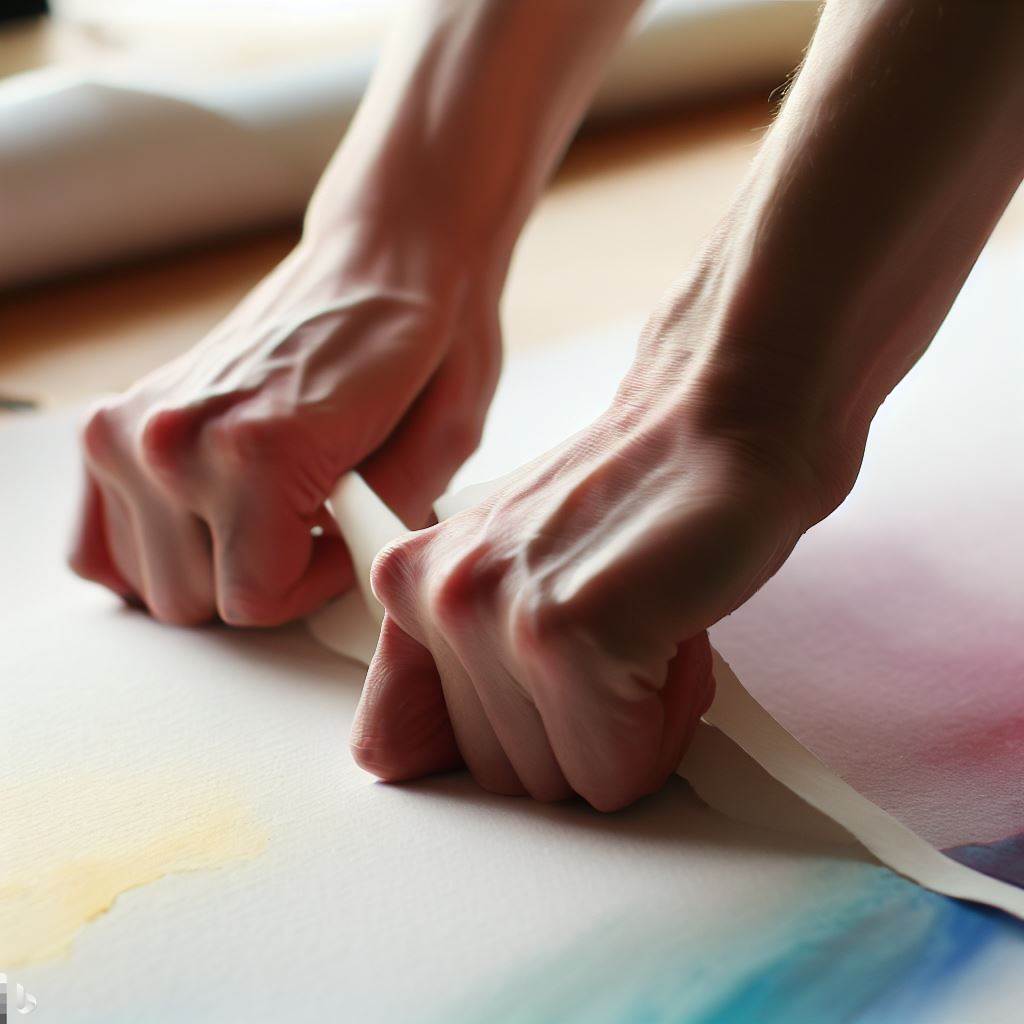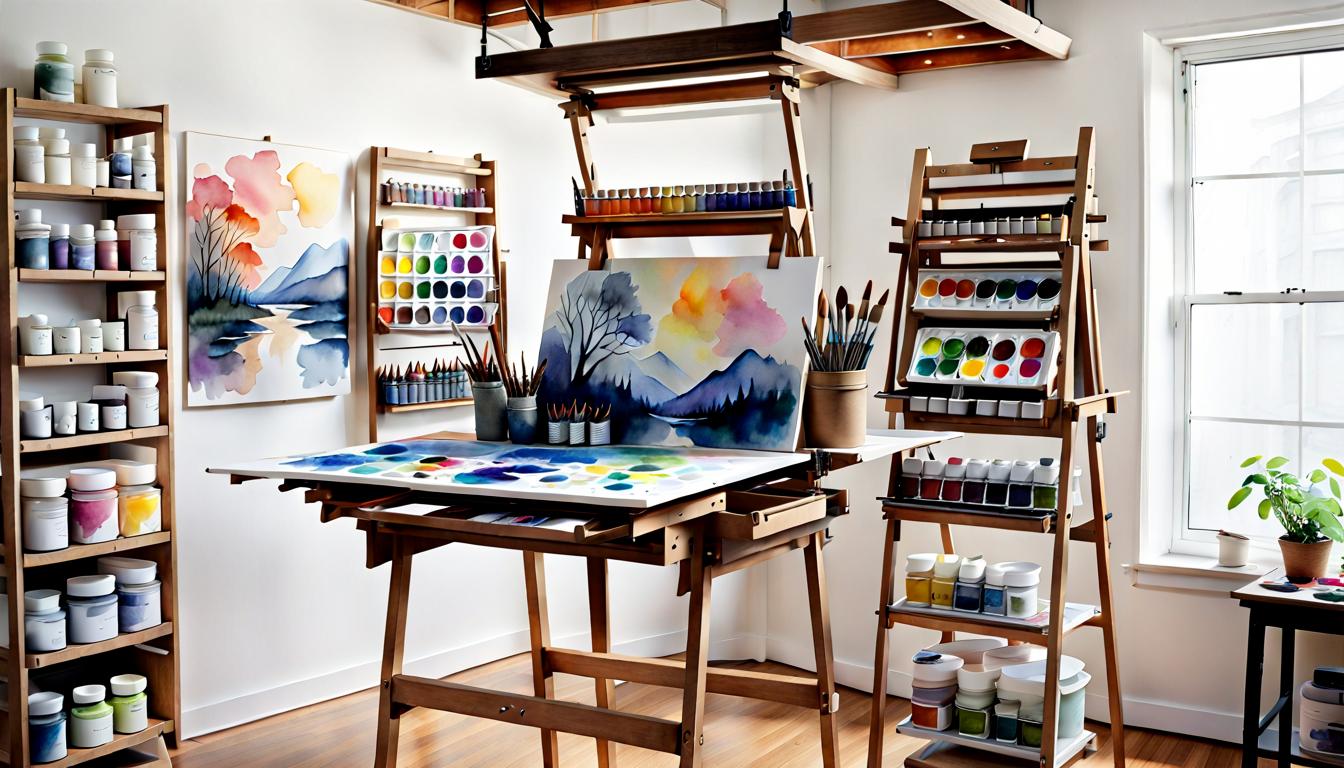Watercolor paper is a porous material that can warp and buckle when it comes into contact with water. Stretching watercolor paper is a technique used to prevent this warping and ensure a smooth painting surface. Here are the steps to stretch watercolor paper:

Which Watercolor Papers require Stretching?
| Paper Type | Paper Material | Weight | Stretching Requirements |
|---|---|---|---|
| Cold-pressed | 100% cotton | 90–300 lb (190–640 gsm) | Soak for 15–20 minutes, then stretch and dry. |
| Hot-pressed | 100% cotton | 90–300 lb (190–640 gsm) | No need to stretch. |
| Rough | 100% cotton | 90–300 lb (190–640 gsm) | Soak for 15–20 minutes, then stretch and dry. |
| Arches | 100% cotton | 300 lb (640 gsm) | Soak for 15–20 minutes, then stretch and dry. |
| Saunders Waterford | 100% cotton | 300 lb (640 gsm) | Soak for 15–20 minutes, then stretch and dry. |
| Fabriano Artistico | 100% cotton | 300 lb (640 gsm) | Soak for 15–20 minutes, |
Materials Needed for Simple Stretching
- Watercolor paper
- A board or flat surface
- Water
- A large, soft brush
- Gummed tape or masking tape
Steps
- Soak the paper: Place the watercolor paper in a tray of clean water for 5-10 minutes until it is completely saturated. Alternatively, you can wet the paper with a large, soft brush and clean water. Make sure the entire surface of the paper is wet.
- Remove excess water: Carefully lift the paper out of the water and let the excess water drip off. You can also blot the paper with a clean towel to remove excess water.
- Place the paper on a board: Lay the wet paper on a board or flat surface. Make sure the board is larger than the paper so that you can tape the edges.
- Tape the edges: Use gummed tape or masking tape to secure the edges of the paper to the board. Make sure the tape is tight and the paper is flat. You can use a bone folder or a similar tool to smooth out any wrinkles or bubbles.
- Let the paper dry: Allow the paper to dry completely. This can take several hours or overnight. Once the paper is dry, it will be stretched tight on the board and will not warp when watercolor is added.
- Paint on the paper: Create your painting on stretched paper. The paper should remain flat and smooth throughout the painting process.
Alternative Methods to Stretching Paper
- Use a watercolor stretching board: A watercolor stretching board is a specialized tool designed for stretching watercolor paper. The paper is soaked in water, placed on the board, and then secured with clips or tape until it dries.
- Use a wet-on-wet technique: This method involves wetting the paper with a large, soft brush and clean water, and then painting on it while it is still wet. This technique can create interesting effects, but it can also cause the paper to warp and buckle.
- Use a dry-mount press: This method involves using a dry-mount press to attach the paper to a rigid surface. This technique is more commonly used for mounting finished artwork, but it can also be used for stretching watercolor paper.
It is important to note that not all watercolor paper needs to be stretched. Heavyweight paper or paper made from 100% cotton fibers may not need to be stretched, and some artists prefer the texture of unstretched paper. However, if you plan to use a lot of water or want to avoid cockling, stretching your paper is recommended.
Tips
- Use a board that is larger than the paper to ensure that the edges can be taped down securely.
- Use gummed tape or masking tape to secure the edges of the paper. Do not use duct tape or other strong tapes that may damage the paper.
- Make sure the paper is completely dry before painting on it. Wet paper can cause the paint to bleed and create unwanted effects.
- If you don’t have a board, you can use a flat surface such as a table or countertop. Just make sure the surface is clean and won’t be damaged by water.
- Some artists prefer to stretch their paper before they begin painting, while others prefer to stretch it after the painting is complete. Experiment with both methods to see which works best for you.
Benefits of stretching watercolor paper
Stretching watercolor paper may seem like an extra step, but it can make a big difference in the quality of your paintings. By following these steps, you can ensure that your paper remains flat and smooth, allowing you to create beautiful watercolor paintings with ease.
Stretching watercolor paper has several benefits that can improve the quality of your paintings. Here are some of the benefits of stretching watercolor paper:
- Taut, even surface tension: Stretching watercolor paper creates a taut, even surface tension that allows the paint to flow evenly and smoothly across the paper. This can result in a more polished and professional-looking painting.
- Eliminates cockling: Cockling is the wrinkling effect that occurs when watercolor paper becomes wet. Stretching watercolor paper can help to eliminate this problem by creating a flat, even surface that resists warping and buckling.
- Improves absorbency: Commercial watercolor paper is treated with sizing to alter its absorbency and improve its handling. Stretching watercolor paper can help to dissolve some of the sizing, creating a better distribution of sizing across the paper and a more receptive surface for paint.
- Allows for more control: When watercolor paper is stretched, it remains flat and stable, allowing for more control over the painting process. This can be especially helpful when working with wet-on-wet techniques or when trying to create fine details.
- Works well with lighter-weight paper: Stretching watercolor paper is particularly useful for lighter-weight paper, which is more prone to warping and buckling. By stretching the paper, you can create a stable surface that can handle multiple washes and layers of paint.
Overall, stretching watercolor paper can help to create a more professional-looking painting with better color distribution and improved handling. While it may take a bit of extra time and effort, the benefits of stretching watercolor paper are well worth it for serious artists.
